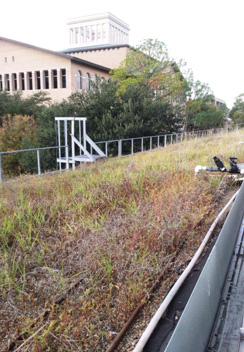|

|

Students ready to breathe new life into eco roof
 The
eco roof at the Burdette Keeland Jr. Design Exploration Center
is about to come back to life. The
eco roof at the Burdette Keeland Jr. Design Exploration Center
is about to come back to life.
Students with the University of Houston�s Horticulture Society
soon will begin planting seeds, including many native Texas
grasses and wildflowers, on the slanted roof of the metal
facility that sits just to the east of the Gerald D. Hines
College of Architecture building.
Dr. Donna Pattison, the faculty adviser for the Horticulture
Society, envisions the project becoming a tool to educate
students and visitors to the types of grasses and plants that
once thrived naturally in the Houston area.
�The plan is to put down at ground level in front of the
building some signs explaining what the plants are that are
growing on the roof,� said Pattison, who is the assistant chair
of Undergraduate Affairs for the Department of Biology and
Biochemistry.
The vegetated roof, which covers about 2,000 square feet on the
south side of the building, originally was installed in 2007.
Over time, its upkeep declined.
Pattison, who is a molecular biologist, began hearing from
students who wanted to revive it. After permission was received
from the College of Architecture to pursue the project, a
handful of students submitted proposals to Pattison on what to
plant on the roof.
�It�s a very brown eco roof at the moment. Not a whole lot is
living up there now. It�s gone completely wild,� Pattison said.
�The Katy Prairie Conservancy is serving as advisers to help
us.�
The existing plant life isn�t being removed, but is being cut
down to about an inch. That, Pattison said, will allow the
existing root structures to keep the synthetic soil in place,
but still allow new seedlings to receive enough sunlight and
space to grow.
�The beds on either end will be sown with a mix of 30 types of
native Texas wildflowers and grasses. The center bed will
feature the interlocking UH logo in red coleus framed by white
falling snow plants on a bed of green ground cover,� Pattison
said. �While the center bed consists of common garden plants
rather than natives, the students wanted to show their school
spirit in plant form.�
An additional two beds, she said, will feature swaths of Texas
wildflowers that will be both visually pleasing and easy to use
to maintain seed reservoirs for future plantings.
The roof is outfitted with a drip irrigation system to bring
water to the seven beds. The water to each bed can be
individually controlled. Over time, that system stopped working
and needed repairs. The College of Architecture still had some
money left over from the original project, so last May the funds
were used to fix it.
The building is one of the original metal buildings built on the
campus. It has gone through several reincarnations over the
years, having served at one time or another as a print shop,
auto shop and even an annex for the UH band.
When the new design center was unveiled in 2007, the roof was
being billed as the only sloped green roof in the city of
Houston. It even received a Certificate of Recognition from Keep
Houston Beautiful.
Besides providing habitats for birds and insects, green roofs
have the potential for cleaning the air, acting as insulation
for a building, and, in large numbers, slightly lowering the
core temperature of urban areas.
Student Christopher Huynh, the treasurer for the UH Horticulture
Society, said the organization wanted to revive the roof for a
number of reasons.
�We support sustainability on campus, and the sloped green roof
is a prime example of sustainable architecture,� Huynh said. �We
saw many advantages to working on the green roof: It was a
semi-isolated environment, so given enough time we could
potentially conduct research up there, and it would also improve
the campus� image as a whole.�
Pattison hopes that, in time, the roof can be used in research
on the benefits of green roofs and how to maintain them in the
hotter southern U.S. climates.
�We�d like to eventually be able to do undergraduate research
using this space, but we don�t have the expertise on campus
quite yet to make that leap,� she said. �Part of what we�re
doing is just learning how to do it, and then we can go back and
start designing undergraduate research projects.�
|
|
